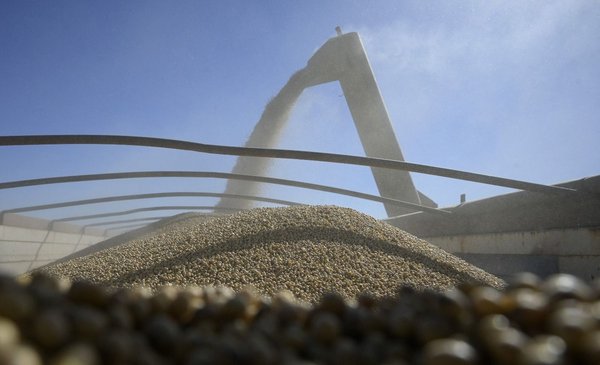Uruguayan agro-exporters view with concern the increased sea freight costs —that can occur due to the ships waiting in the port of Montevideo—while the conflict spreads between the Single Port Union and Related Branches (Supra) and the company Montecon for the announcement of the dismissal of 150 workers.
So far, there have been no problems with the loadsreported to The Observer Gabriel Di Giovannantonio, manager of Cargill, a grain exporting company. “The biggest problem is if the boats start waiting because the line up (ship docking sequence) it starts to get congested and the costs for delays start to increase. And those costs are paid by the country, because in one way or another the entire logistics chain is paying them,” he warned.
In the middle of the soybean harvest, any conflict that interrupts the normal flow of merchandise complicatesassured.
About 600 thousand tons of soy
Néstor Marrero, general manager of the Terminal de Graneles Montevideo (TGM), a terminal through which ships with soybeans depart, explained that in the line up There are 10 ships from that terminal for this campaign. As reported, so far there have been no delays. “Currently we do not have ships waiting because there is a delay in the different terminals from which they come. That is why, as they arrive, they enter, until now,” he detailed.
The company that operates in TGM is not unionized, so operations have not stopped, assured. “For now we are operating normally both in the receipt of trucks and in the loading of ships,” she said. As he explained, she works at TGM from Monday to Sunday, 24 hours a day.
The first ship with soybeans destined for China left on April 26 with 35 thousand tons, and the second this Monday, with 25 thousand tons. The third will be released this Thursday, May 12. Most load first at the port of Nueva Palmira and are completed in Montevideo. In the coming weeks, two “full Montevideo” vessels will be loaded with 60,000 tons of oilseed. The peak of activity is expected next week.
This year it is estimated that 600 thousand tons of soybeans will pass through that terminalhe detailed, 90% destined for the Asian market.
The trails won’t stop
In the middle of the harvest and with weather forecasts that do not announce rain for this week, the threshing continues to develop in a good way and what is expected is that it will continue like this.
Di Giovannantonio maintained that in the storage plants there is still capacity to receive grainsso the port conflict would not interfere with those loads.
Diego Guigou, manager of agricultural production of Agribusiness del Plata (ADP), commented that costs also go up at the field levelbecause, due to delays, “you have to make a move so that the grain that was bound for the port ends up elsewhere, to be able to harvest the harvest”.
“It’s quite a problem, it’s a fairly complicated measure,” he said, but assured that the threshing will not stop.
These price increases are added to production and logistics costs. that Uruguayan farmers face this harvest, with an increase in values of twofold in some casessuch as in maritime transport.
“We are in a good harvest, mainly due to yield. The costs have increased a lot but luckily we have a good harvest that allows us to face them, otherwise it would be impossible”, Di Giovannantonio admitted.
JUAN MABROMATA / AFP
The union’s actions come amid the largest soybean harvest in history.
Forecasts point to a soybean harvest that will be around 3 million tons. This volume implies a movement of 100,000 truck trips in about 45 days. The oilseed can leave the country with a floor of some US$ 1,700 million for exports, very close to the maximum of almost a decade ago. According to data from the Directorate of Agricultural Statistics (DIEA) of the Ministry of Livestock, in this campaign there are 450,428 ha that were soybean first and 530,262 ha second.
Unemployment: a logistical chaos
Waiting for new resolutions from Supra, the exporting companies and the collectors are looking carefully at the situation and with caution announcement of a possible 72-hour strike. The senator Sebastian DaSilvasaid Uruguay would not resist a 72-hour strike, less so in the midst of the largest harvest in history. “A 72-hour strike would generate logistical chaos of unimaginable magnitude,” he told Telemundo, adding that if he were the Minister of Labor and Social Security, he would have the essentials on the table so that the port does not stop.
For her part, Teresa Aishemberg, Manager of the Union of Exporters, said in Added Value of Carve that “essentiality cannot be accepted because it is not considered part of the services included in the decree.”
“We are surrounded by uncertainty because this creates delays and decreases efficiency. The port is part of our competitiveness and is a very important link in the chain so that our product arrives in a timely manner and that dynamic flow of export or import of supplies does not stop, ”he commented.
ANDIn the port of Nueva Palmira there are also delays, although in this case they have nothing to do with union measures. The president of the Interunion of Professional Land Freight Transport of Uruguay (ITPC), Ignatius AsumendiHe reported that in the Port of Nueva Palmira there are delays of between two and three hours to weigh the loads at the control posts of the Ministry of Transport and Public Works (MTOP).
The congestion occurs mainly in the afternoon hours, since the trucks arrive at that time of the day and the scales are saturated. “The harvest is very strong and there is an overflow of trucks, they are not giving enough,” he indicated and said that from the union they have already communicated with the General Director of the MTOP to find a way to decongest the situation.







